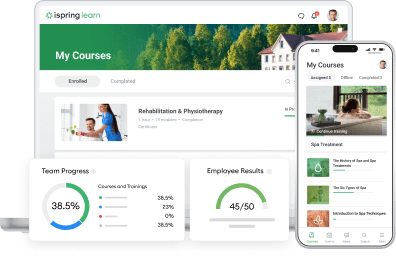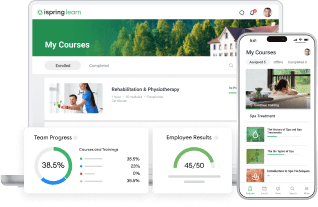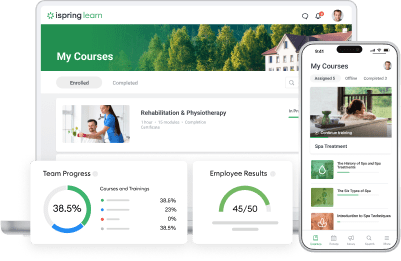HR Compliance Training: A Practical Guide for 2025
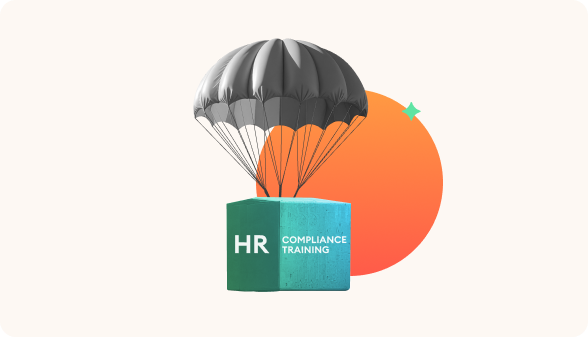
Effective HR compliance training is crucial to ensure that employees understand workplace regulations, legal requirements, and organizational policies. It helps mitigate risks, improves workplace culture, and enhances employee productivity.
With ever-evolving state laws and regulations, HR managers and Learning and Development professionals must educate employees on key compliance topics, such as workplace safety, sexual harassment, and equal opportunity employment.
To ensure compliance, HR professionals need a strategic approach that includes choosing the right HR compliance training courses, using online training platforms, and collaborating with legal counsel to meet all training requirements.
This guide explores why compliance training matters, breaks down the key HR and L&D challenges eLearning can solve, and demonstrates how organizations can use an LMS to build a foundation of online HR compliance training.
What Is HR Compliance Training?
HR compliance training is the structured process of educating employees and management about laws, regulations, and company policies that govern workplace behavior, operations, and standards. Thanks to this, everyone in the organization understands their responsibilities and the consequences of non-compliance.
HR compliance training is essential for employees across all levels:
- New hires: during onboarding, to familiarize them with company policies and legal expectations.
- Managers and supervisors: to equip them with knowledge of labor laws and the skills to handle compliance issues effectively.
- Specialized roles: departments like HR, IT, and finance require in-depth training that’s relevant to their responsibilities.
Why HR Compliance Training Matters in 2025
Organizations must stay ahead of changes in legislation to protect employees and build an inclusive workplace. Let’s explore why compliance training should be one of the top priorities in corporate education.
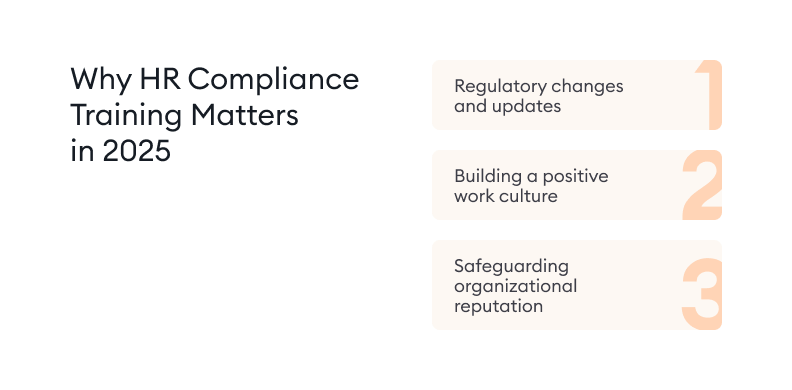
Regulatory changes and updates
The business world in 2025 is being shaped by dynamic changes in laws and regulations. HR compliance training should keep employees informed, which is necessary to stay compliant with federal laws and avoid penalties.
Businesses must keep up with:
- New remote work laws and hybrid workforce policies.
- Increased enforcement of workplace safety regulations.
- Stricter sexual harassment training requirements at the state and federal levels.
For example, consider the Fair Labor Standards Act (FLSA), which establishes minimum wage, overtime pay, and recordkeeping standards for employees in the U.S. If a company unknowingly misclassifies employees as exempt from overtime pay, it could face costly lawsuits and penalties.
Building a positive work culture
A well-trained workforce fosters an ethical and inclusive culture where employees feel safe and respected. This includes:
- Encouraging cultural awareness to prevent discrimination.
- Promoting equal employment opportunity through unbiased hiring practices.
- Implementing anti-harassment policies to maintain workplace integrity.
Safeguarding organizational reputation
Non-compliance can result in lawsuits, financial penalties, and reputational damage. Proactive HR compliance training helps:
- HR professionals maintain legal compliance and ethical standards.
- Organizations reduce risks by educating employees on workplace policies.
- Businesses build trust with employees, customers, and stakeholders.
Key Topics in HR Compliance Training
HR compliance training might cover various essential topics to ensure legal and ethical workplace practices. These training programs help businesses meet regulatory requirements and uphold industry standards.
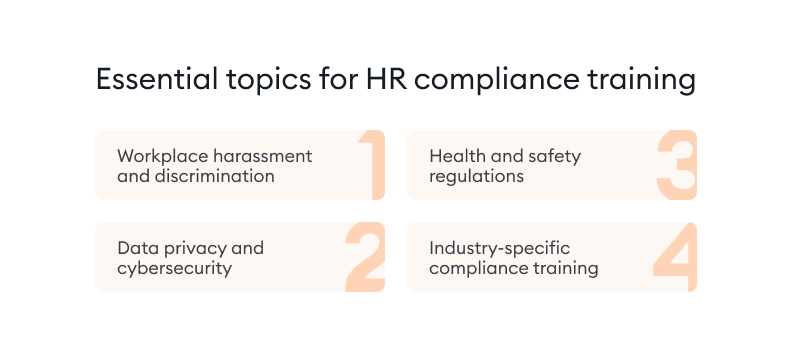
Workplace harassment and discrimination
HR compliance training should educate workers about recognizing and reporting inappropriate behavior. Training should cover:
- Identifying and preventing workplace violence and sexual harassment.
- Understanding protected classes and anti-discrimination laws.
- Reporting mechanisms and bystander intervention training.
In 2017, Uber faced numerous allegations of sexual harassment and a toxic work environment. In response, the company implemented mandatory anti-harassment training for all employees, introduced clear reporting channels, and strengthened its commitment to diversity and inclusion. This comprehensive approach led to significant improvements in workplace culture and a reduction in harassment complaints.
Data privacy and cybersecurity
With increasing cyber threats, HR compliance training should educate employees on:
- Data protection laws like GDPR and HIPAA.
- Best practices for handling sensitive information.
- Identifying and preventing phishing and cyberattacks.
In November 2021, Robinhood Markets experienced a significant data breach in which an unauthorized party accessed the personal information of millions of customers by impersonating a company employee. The breach exposed the email addresses of approximately 5 million users and the full names of about 2 million others. In response, Robinhood’s brokerage units agreed to a $45 million settlement with the Securities and Exchange Commission (SEC) over various violations, including inadequate policies to protect customer data and guard against identity theft. This incident underscores the need for comprehensive data privacy and cybersecurity training to prevent unauthorized access and protect sensitive information.
Diversity, equity, and inclusion (DEI)
A strong DEI program ensures equal opportunities for all employees. Training should include:
- Implicit bias awareness and mitigation.
- Strategies for fostering an inclusive workplace.
- Anti-discrimination laws and fair hiring practices.
In 2023, the Bank of England invested nearly £100,000 in diversity and inclusion training for its employees over three years. This initiative included 66 ‘active bystander’ sessions, 24 ‘let’s talk about race’ sessions, and 24 ‘disability in the workplace’ sessions. The training aimed to promote equality and unlock talent within the financial services sector, supported by senior leadership participation.
Here is an example of an online DEI course created with iSpring Suite, an easy-to-use authoring tool based on PowerPoint.
Health and safety regulations
Training should address workplace safety protocols, including:
- OSHA compliance and industry-specific safety regulations.
- Emergency response and hazard identification.
- Ergonomic best practices for remote and in-office employees to ensure a safe work environment and well-being for all workers.
In 2024, Dollar General agreed to pay a $12 million penalty to settle alleged safety violations identified by the Occupational Safety and Health Administration (OSHA). The infractions included blocked fire exits, obstructed fire extinguishers, and unsafe storage practices across their 19,000 stores. As part of the settlement, Dollar General committed to enhancing workplace safety by developing a safety and health committee, providing comprehensive employee training, reducing inventory, and improving stocking efficiency. Additionally, the company hired third-party consultants to conduct unannounced compliance audits and established an anonymous safety concern hotline. This case shows the importance of workplace safety training in preventing hazards and ensuring compliance with safety regulations.
Industry-specific compliance training
Certain industries require specialized compliance training to meet regulatory requirements. This ensures that employees in healthcare, finance, and other highly regulated sectors understand and follow industry-specific laws and guidelines. Organizations that fail to provide industry-specific compliance training can face regulatory audits, fines, or loss of operating licenses.
Examples:
- Healthcare: HIPAA compliance training to protect patient information.
- Finance: Anti-money laundering (AML) training to detect fraudulent activities.
- Construction: OSHA safety training to prevent workplace injuries.
Challenges in HR Compliance Training
Despite its importance, HR compliance training presents a number of challenges. HR departments must adopt innovative strategies to overcome these issues and enhance training effectiveness.
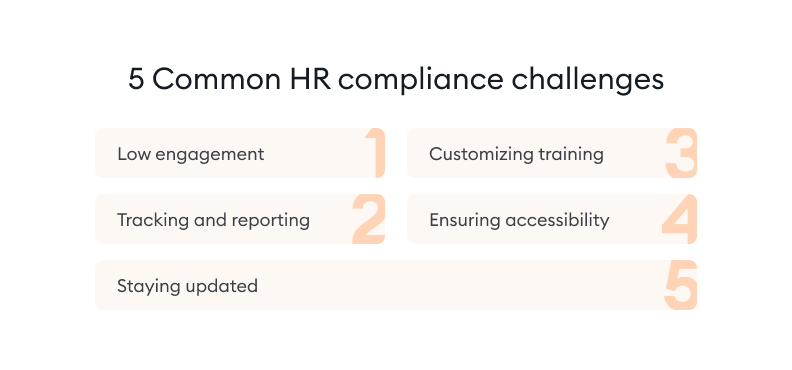
Low engagement
Traditional human resource compliance training is often seen as dull and repetitive. To overcome this challenge, organizations must:
- Use interactive and engaging training methods.
- Provide real-world examples and case studies.
- Implement gamification to encourage participation.
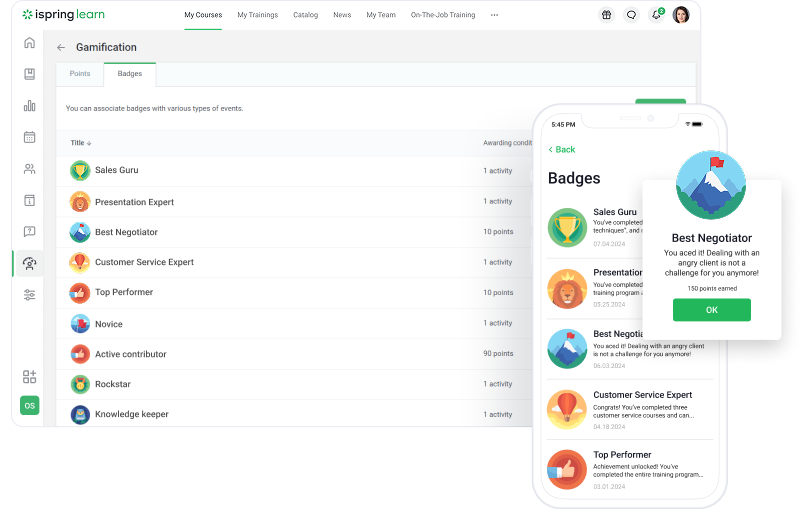
A gamified LMS like iSpring Learn integrates game mechanics like points, badges, and leaderboards into the learning platform.
Tracking and reporting
Ensuring compliance training completion can be difficult. This can be solved by:
- Using an LMS to automate tracking and reporting.
- Requiring periodic refresher courses.
- Monitoring employee progress with analytics tools.
Customizing training
Different roles require different compliance training. Organizations should:
- Personalize training based on job responsibilities.
- Offer role-specific compliance modules.
- Use adaptive learning techniques.
Ensuring accessibility
Employees should have easy access to compliance training, regardless of location or ability. In this respect, best practices include:
- Offering mobile-friendly training.
- Providing multilingual support.
- Ensuring compliance with accessibility standards (e.g., WCAG).
Staying updated
Compliance laws change frequently. To stay current, businesses should:
- Conduct regular training updates.
- Work with legal and HR experts.
- Use an LMS that provides automatic regulatory updates.
Why Choose the iSpring Learn LMS for Compliance Training?
Choosing the right LMS for HR compliance training can simplify the process, enhance engagement, and ensure regulatory adherence. The iSpring Learn LMS is a comprehensive, user-friendly platform that allows you to meet your compliance training needs. Here’s how it can help you streamline your compliance training:
Ease of use
The iSpring Learn LMS offers an intuitive interface, making it easy for HR teams to manage all aspects of compliance training. Employees can quickly access and complete courses without technical difficulties.
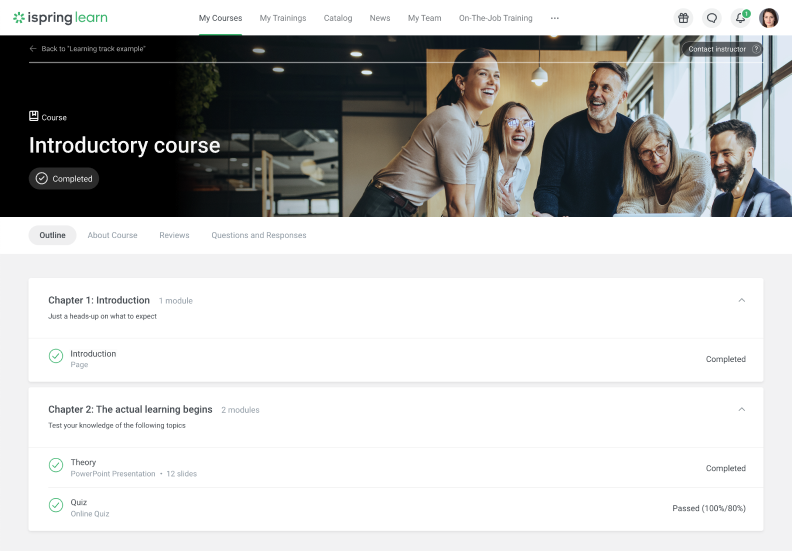
Customizable training modules
Organizations can tailor training to specific roles, departments, or industries. With iSpring Learn, you can create different learning tracks depending on the role and individual needs. To do this, you need to pick the files and courses you need and put them in a certain order for a student (or a group of students) to master.
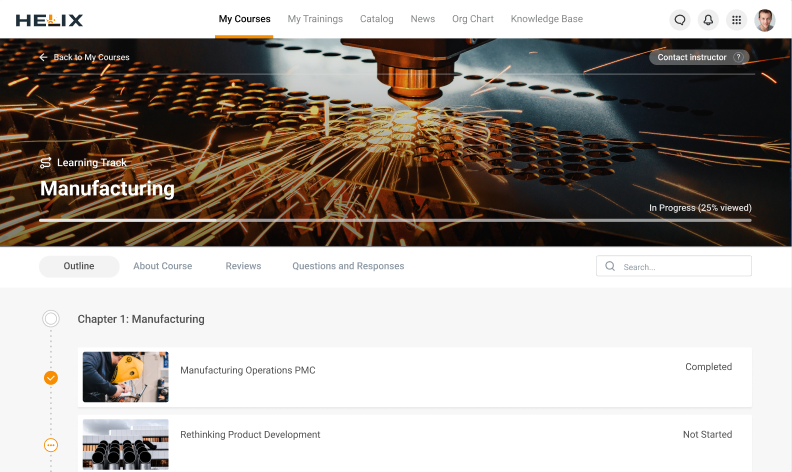
Interactive content
Modern learners tend to get distracted easily, especially if they find the training subject difficult. The more interactive and diversified your content is, the higher the chance of a successfully completed course. iSpring Learn is bundled with the iSpring Suite authoring tool, which enables the creation of interactive training using:
- Quizzes and knowledge checks.
- Video-based learning modules.
- Role-playing scenarios and simulations.
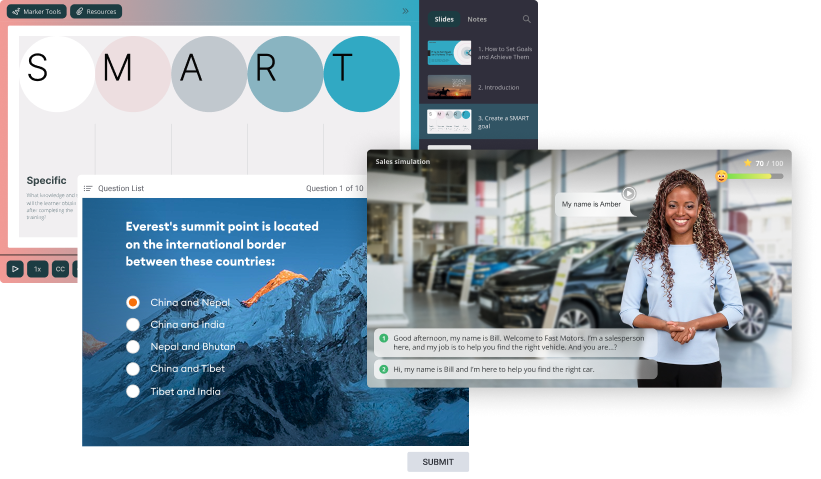
Comprehensive reporting tools
The platform offers real-time tracking, ensuring that HR teams and supervisors can:
- Monitor training completion rates.
- Identify knowledge gaps.
- Generate compliance audit reports with ease.
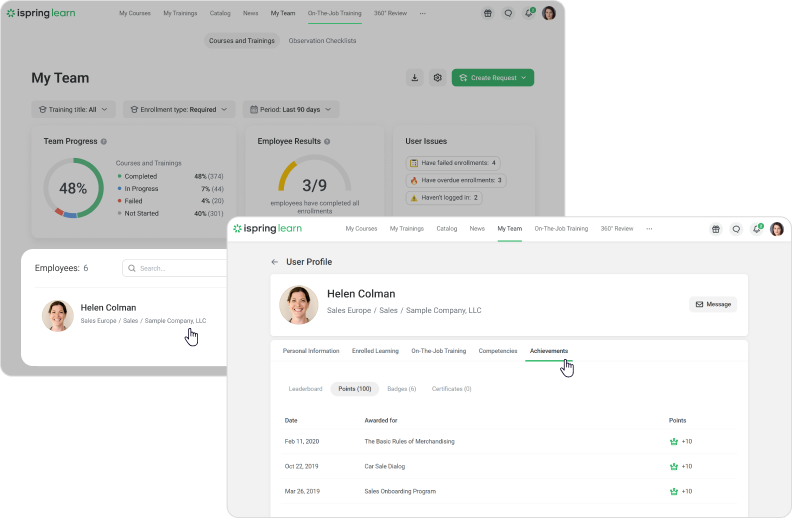
Mobile learning
With the mobile app offered by iSpring Learn, employees can complete training anytime, anywhere. This is especially useful for remote and hybrid workforces.
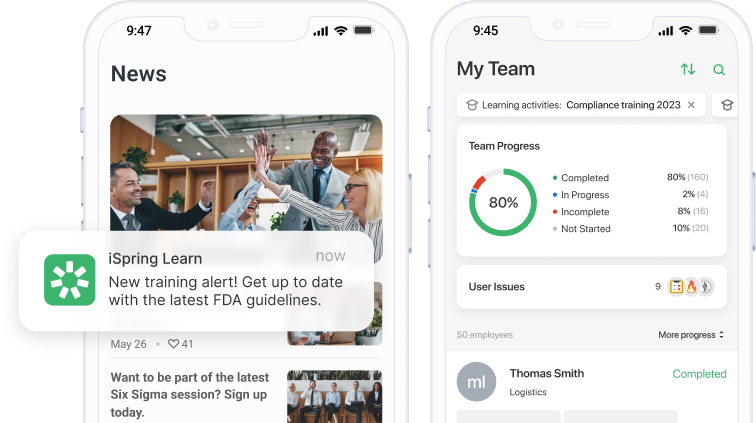
Rapid deployment
iSpring Learn allows organizations to roll out compliance training programs quickly without lengthy setup processes.
For example, using iSpring Learn, Castle, a construction services provider, was able to launch efficient online training to meet compliance requirements and tight time frames. They streamlined onboarding and reduced downtime. Now, the company can send training out and have employees complete it before they arrive at the site. They also use iSpring Learn to run annual retraining in accordance with OSHA requirements and industry best practices.
Steps to Implement Effective HR Compliance Training with the iSpring Learn LMS
Implementing HR compliance training requires a structured approach. Here is a step-by-step plan to introduce this practice in your organization.
1. Set training goals: define a set of business metrics you’d like to improve with the new initiative.
2. Assess training needs: identify key compliance topics and target audiences, such as new hires, managers, and supervisors, or specialized roles.
3. Establish an LMS implementation plan: this will be the basic document that will help you deliver all the steps on time and measure results afterward. Book a free live demo with an iSpring eLearning specialist to dive into your project specifics and get a step-by-step plan for your company.
4. Assign roles to your implementation team members: decide who will create the training content, administer the LMS, and support the users.
5. Create engaging content: use the iSpring Suite authoring tool to design interactive and multimedia-rich courses.
6. Segment your audience: customize training for different employee groups based on roles and responsibilities.
7. Announce the launch of your LMS: make sure all employees know about the upcoming training, as well as the concrete timelines and steps they need to take, such as downloading a mobile LMS app to their smartphones.
8. Set up your LMS: this step includes customizing the look and feel of your platform, adding user data or synchronizing with your HR system, assigning admin roles, setting up user accounts, etc.
9. Assign a course with a deadline: select a group of users who need to complete a training program. The platform will notify them of the assignment and its deadline.
10. Monitor progress and feedback: utilize iSpring’s analytics to track completion rates and gather employee feedback.
11. Evaluate the results of your training: review the training goals you identified earlier and present the overall training completion rate. Discuss how the training affected business goals with stakeholders.
12. Stay proactive: update training materials regularly to reflect changes in laws and best practices.
You can find more examples of successful HR compliance training implementation in this article.
Best Practices for HR Compliance Training
To enhance engagement and knowledge retention, L&D professionals can use the following strategies:
Incorporate real-life scenarios: role-plays and case studies help employees relate to the training material.
Leverage microlearning: break down complex topics into bite-sized modules for better retention.
Encourage continuous learning: provide refresher courses to reinforce key concepts.
Use gamification: add leaderboards, badges, and rewards to make learning more engaging.
Foster open communication: encourage employees to ask questions and provide feedback during and after training sessions.
Measuring the ROI of HR Compliance Training
Tracking the return on investment of HR compliance training helps businesses assess its effectiveness. To evaluate if your training program is having the desired effect, you can measure these parameters:
Reduced incidents of non-compliance: track how training impacts adherence to regulations.
Employee satisfaction and retention: well-informed employees are more confident and satisfied, leading to lower turnover rates.
Time and cost savings: automated systems like iSpring Learn minimize the administrative workload.
Improved organizational reputation: compliance training boosts credibility with clients and stakeholders.
FAQ
1. What are the main topics in of HR compliance training?
Topics include workplace safety, sexual harassment, equal employment opportunity, data privacy, and DEI training.
2. Why should HR professionals use an LMS for compliance training?
An LMS simplifies training requirements, ensures tracking, and improves engagement.
3. How does HR compliance training protect businesses?
It reduces legal risks, prevents compliance violations, and fosters a positive workplace culture.
4. Can compliance training be customized for different industries?
Yes, HR departments can create tailored HR compliance training courses for specific roles and industries.
5. How often should compliance training be updated?
Regular updates ensure compliance with evolving state laws and federal regulations.
Conclusion
In 2025, HR compliance training is more critical than ever. By leveraging modern tools like iSpring Learn LMS, organizations can deliver engaging, effective, and scalable training that ensures adherence to regulations and fosters a positive workplace environment. Properly organized compliance training protects your organization and empowers your workforce to thrive. Book a free live demo of iSpring Learn to get more helpful insights from iSpring experts on your HR compliance training project!





